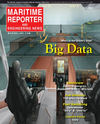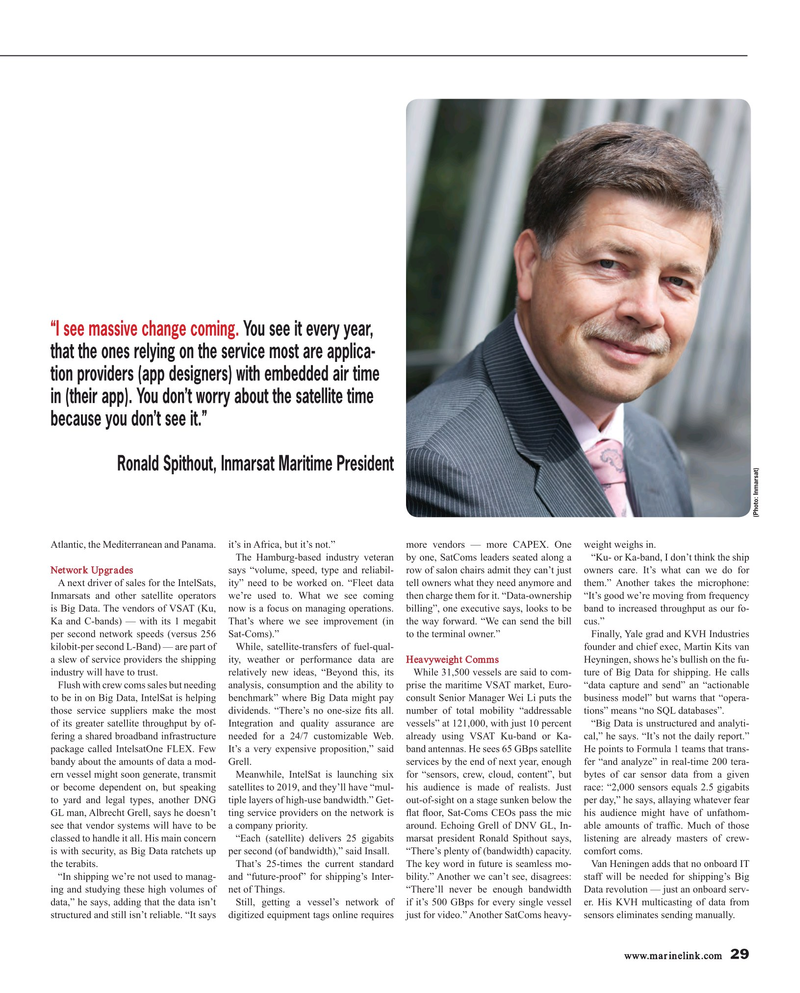
Page 29: of Maritime Reporter Magazine (July 2015)
Marine Communications Edition
Read this page in Pdf, Flash or Html5 edition of July 2015 Maritime Reporter Magazine
“I see massive change coming. You see it every year, that the ones relying on the service most are applica- tion providers (app designers) with embedded air time in (their app). You don’t worry about the satellite time because you don’t see it.”
Ronald Spithout, Inmarsat Maritime President (Photo: Inmarsat)
Atlantic, the Mediterranean and Panama. it’s in Africa, but it’s not.” more vendors — more CAPEX. One weight weighs in.
The Hamburg-based industry veteran by one, SatComs leaders seated along a “Ku- or Ka-band, I don’t think the ship
Network Upgrades says “volume, speed, type and reliabil- row of salon chairs admit they can’t just owners care. It’s what can we do for
A next driver of sales for the IntelSats, ity” need to be worked on. “Fleet data tell owners what they need anymore and them.” Another takes the microphone:
Inmarsats and other satellite operators we’re used to. What we see coming then charge them for it. “Data-ownership “It’s good we’re moving from frequency is Big Data. The vendors of VSAT (Ku, now is a focus on managing operations. billing”, one executive says, looks to be band to increased throughput as our fo-
Ka and C-bands) — with its 1 megabit That’s where we see improvement (in the way forward. “We can send the bill cus.” per second network speeds (versus 256 Sat-Coms).” to the terminal owner.” Finally, Yale grad and KVH Industries kilobit-per second L-Band) — are part of While, satellite-transfers of fuel-qual- founder and chief exec, Martin Kits van a slew of service providers the shipping ity, weather or performance data are Heavyweight Comms Heyningen, shows he’s bullish on the fu- industry will have to trust. relatively new ideas, “Beyond this, its While 31,500 vessels are said to com- ture of Big Data for shipping. He calls
Flush with crew coms sales but needing analysis, consumption and the ability to prise the maritime VSAT market, Euro- “data capture and send” an “actionable to be in on Big Data, IntelSat is helping benchmark” where Big Data might pay consult Senior Manager Wei Li puts the business model” but warns that “opera- those service suppliers make the most dividends. “There’s no one-size ? ts all. number of total mobility “addressable tions” means “no SQL databases”. of its greater satellite throughput by of- Integration and quality assurance are vessels” at 121,000, with just 10 percent “Big Data is unstructured and analyti- fering a shared broadband infrastructure needed for a 24/7 customizable Web. already using VSAT Ku-band or Ka- cal,” he says. “It’s not the daily report.” package called IntelsatOne FLEX. Few It’s a very expensive proposition,” said band antennas. He sees 65 GBps satellite He points to Formula 1 teams that trans- bandy about the amounts of data a mod- Grell. services by the end of next year, enough fer “and analyze” in real-time 200 tera- ern vessel might soon generate, transmit Meanwhile, IntelSat is launching six for “sensors, crew, cloud, content”, but bytes of car sensor data from a given or become dependent on, but speaking satellites to 2019, and they’ll have “mul- his audience is made of realists. Just race: “2,000 sensors equals 2.5 gigabits to yard and legal types, another DNG tiple layers of high-use bandwidth.” Get- out-of-sight on a stage sunken below the per day,” he says, allaying whatever fear
GL man, Albrecht Grell, says he doesn’t ting service providers on the network is ? at ? oor, Sat-Coms CEOs pass the mic his audience might have of unfathom- see that vendor systems will have to be a company priority. around. Echoing Grell of DNV GL, In- able amounts of traf? c. Much of those classed to handle it all. His main concern “Each (satellite) delivers 25 gigabits marsat president Ronald Spithout says, listening are already masters of crew- is with security, as Big Data ratchets up per second (of bandwidth),” said Insall. “There’s plenty of (bandwidth) capacity. comfort coms. the terabits. That’s 25-times the current standard The key word in future is seamless mo- Van Heningen adds that no onboard IT “In shipping we’re not used to manag- and “future-proof” for shipping’s Inter- bility.” Another we can’t see, disagrees: staff will be needed for shipping’s Big ing and studying these high volumes of net of Things. “There’ll never be enough bandwidth Data revolution — just an onboard serv- data,” he says, adding that the data isn’t Still, getting a vessel’s network of if it’s 500 GBps for every single vessel er. His KVH multicasting of data from structured and still isn’t reliable. “It says digitized equipment tags online requires just for video.” Another SatComs heavy- sensors eliminates sending manually.
www.marinelink.com 29
MR #7 (26-33).indd 29 MR #7 (26-33).indd 29 7/6/2015 10:16:03 AM7/6/2015 10:16:03 AM

 28
28

 30
30
